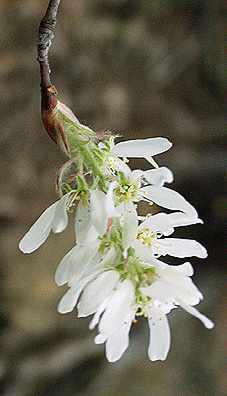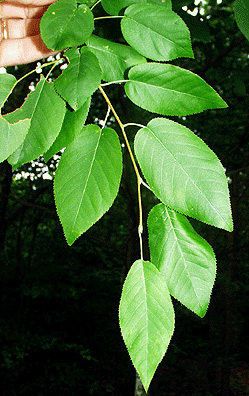Name That Tree
By Gretchen Spencer, Fairfax Master Gardener
 If you chose Downy Serviceberry (Amelanchier arborea), you are correct. I became familiar with this tree when three were planted outside the front of the school where I worked several years ago. I can attest to the serviceberry’s showy white flowers and its delicious fruit. Teachers and children alike enjoyed sampling the ripe berries when in front of the school in their carpools. The fruit is similar to blueberries, though a little sweeter, and is prized by both birds and people. It is said that the berries make a delicious pie or jam, if you are lucky to pick enough before the birds get them. I’ve often wondered why I don’t see more serviceberries planted in people’s yards. In fact, the serviceberry is on my list of trees to plant in my yard. Hopefully, by the end of this article, you will want to plant one, too.
If you chose Downy Serviceberry (Amelanchier arborea), you are correct. I became familiar with this tree when three were planted outside the front of the school where I worked several years ago. I can attest to the serviceberry’s showy white flowers and its delicious fruit. Teachers and children alike enjoyed sampling the ripe berries when in front of the school in their carpools. The fruit is similar to blueberries, though a little sweeter, and is prized by both birds and people. It is said that the berries make a delicious pie or jam, if you are lucky to pick enough before the birds get them. I’ve often wondered why I don’t see more serviceberries planted in people’s yards. In fact, the serviceberry is on my list of trees to plant in my yard. Hopefully, by the end of this article, you will want to plant one, too.
A member of the rose family (Rosaceae), this native tree is found in eastern and midwestern forests from Maine to Iowa and south to northern Florida and Louisiana in full sun to partial shade. It generally grows from 15 to 25 feet high, though it can grow to 40 feet or higher. It also grows as a large, multi-stemmed shrub. Adaptable to a range of sites, it can be found growing in swampy lowlands to dry woods as well as rocky ridges and open woodlands. It can also grow in acid to high pH soils, moist to dry.
 The 1- to 3-inch long leaves of the downy serviceberry are alternate, simple and ovate with serrate margins. The “downy” in its name refers to the fact that the new leaves are covered with many hairs. The leaves turn vivid shades of yellow, apricot and red in the fall. The smooth gray bark, becoming ridged and furrowed with maturity, offers winter interest.
The 1- to 3-inch long leaves of the downy serviceberry are alternate, simple and ovate with serrate margins. The “downy” in its name refers to the fact that the new leaves are covered with many hairs. The leaves turn vivid shades of yellow, apricot and red in the fall. The smooth gray bark, becoming ridged and furrowed with maturity, offers winter interest.
Though short-lived, the bright white flowers that appear in mid-March to April in drooping racemes or clusters 2 to 4 inches long steal the show. Appearing early, either just before or with the leaves, the flowers are associated with the arrival of spring. They soon give way to berries in June about the size of blueberries that mature from green to red, to a dark bluish black. Over 40 species of birds and many species of mammals such as squirrels, chipmunks, mice, foxes and black bears eat the fruit. As mentioned above, humans enjoy the fruit, too.

bark
Since it is a member of the rose family, downy serviceberry may suffer from rusts, blights, powdery mildew, leaf miners, leaf spot, borers and scale. Selecting resistant cultivars and maintaining good cultural practices such as watering and fertilizing help to keep these problems from becoming serious. There are several other related species such as the Alleghany serviceberry (Amelanchier laevis), which is most closely related to the downy serviceberry, and Shadblow serviceberry (Amelanchier canadensis), which tends to grow as an upright, suckering, multi-stemmed shrub.
If you are looking for a small native tree to plant in a naturalistic setting, or on the edge of a woodland, or even as a specimen tree planted singly or in a group, consider the native downy serviceberry. It provides interesting attributes in all seasons, and the birds and wildlife will be very grateful!
References
Serviceberry, HGIC 1026, Clemson Cooperative Extension
Downy Serviceberry, Arbor Day Foundation
Downy Serviceberry, Department of Horticulture, University of Kentucky
Downy Serviceberry, Virginia Tech Dendrology
Dirr’s Encyclopedia of Trees & Shrubs, 1st edition, Michael A. Dirr, 2011